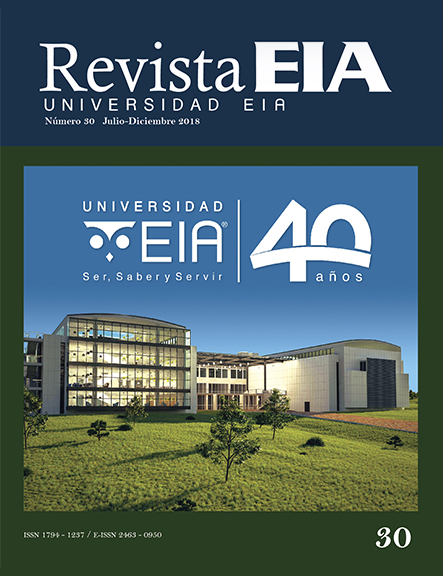Factores de influencia en la coordinación logística para la preparación y atención de desastres – Una revisión de literatura
Factores de influencia en la coordinación logística para la preparación y atención de desastres – Una revisión de literatura
Barra lateral del artículo
Términos de la licencia (VER)
Declaración del copyright
Los autores ceden en exclusiva a la Universidad EIA, con facultad de cesión a terceros, todos los derechos de explotación que deriven de los trabajos que sean aceptados para su publicación en la Revista EIA, así como en cualquier producto derivados de la misma y, en particular, los de reproducción, distribución, comunicación pública (incluida la puesta a disposición interactiva) y transformación (incluidas la adaptación, la modificación y, en su caso, la traducción), para todas las modalidades de explotación (a título enunciativo y no limitativo: en formato papel, electrónico, on-line, soporte informático o audiovisual, así como en cualquier otro formato, incluso con finalidad promocional o publicitaria y/o para la realización de productos derivados), para un ámbito territorial mundial y para toda la duración legal de los derechos prevista en el vigente texto difundido de la Ley de Propiedad Intelectual. Esta cesión la realizarán los autores sin derecho a ningún tipo de remuneración o indemnización.
La autorización conferida a la Revista EIA estará vigente a partir de la fecha en que se incluye en el volumen y número respectivo en el Sistema Open Journal Systems de la Revista EIA, así como en las diferentes bases e índices de datos en que se encuentra indexada la publicación.
Todos los contenidos de la Revista EIA, están publicados bajo la Licencia Creative Commons Atribución-NoComercial-NoDerivativa 4.0 Internacional
Licencia
![]()
Esta obra está bajo una Licencia Creative Commons Atribución-NoComercial-NoDerivativa 4.0 Internacional
Contenido principal del artículo
Resumen
Descargas
Detalles del artículo
Referencias (VER)
Afsar, H. M.; Prins, C.; Santos, A. C. (2014). Exact and heuristic algorithms for solving the generalized vehicle routing problem with flexible fleet size. International Transactions in Operational Research, 21 (1), pp. 153-175. DOI: 10.1111/itor.12041
Afshar, A.; Haghani, A. (2012). Modeling integrated supply chain logistics in real-time large-scale disaster relief operations. Socio-Economic Planning Sciences, 46 (4), pp. 327-338. DOI: 10.1016/j.seps.2011.12.003
Akhtar, P.; Marr, N. E.; Garnevska, E. V. (2012). Coordination in humanitarian relief chains: chain coordinators. Journal of Humanitarian Logistics and Supply Chain Management, 2 (1), pp. 85-103. DOI: 10.1108/20426741211226019
Altay, N.; Green, W. G. (2006). OR/MS research in disaster operations management. European Journal of Operational Research, 175 (1), pp. 475–493. DOI: 10.1016/j.ejor.2005.05.016
Altay, N.; Pal, R. (2014). Information Diffusion among Agents: Implications for Humanitarian Operations. Production and Operations Management, 23 (6), pp. 1015-1027. DOI: 10.1111/poms.12102
Anaya-Arenas, A. M.; Renaud, J.; Ruiz, A. (2014). Relief distribution networks: a systematic review. Annals of Operations Research, 223 (1), pp. 53-79. DOI: 10.1007/s10479-014-1581-y
Balcik, B.; Beamon, B. M. (2008). Facility location in humanitarian relief. International Journal of Logistics: Research and Applications, 11 (2), pp. 101-121. DOI: 10.1080/13675560701561789
Balcik, B.; Beamon, B. M.; Krejci, C. C.; Muramatsu, K. M.; Ramirez, M. (2010). Coordination in humanitarian relief chains: Practices, challenges and opportunities. International Journal of Production Economics, 126 (1), pp. 22-34. DOI: 10.1016/j.ijpe.2009.09.008
Baldini, G.; Oliveri, F.; Braun, M.; Seuschek, H.; Hess, E. (2012). Securing disaster supply chains with cryptography enhanced RFID. Disaster Prevention and Management: An International Journal, 21 (1), pp. 51-70. DOI: 10.1108/09653561211202700
Chakravarty, A. K. (2014). Humanitarian relief chain: Rapid response under uncertainty. International Journal of Production Economics, 151 (1), pp. 146-157. DOI: 10.1016/j.ijpe.2013.10.007
Charles, A.; Lauras, M. (2011). An enterprise modelling approach for better optimisation modelling: application to the humanitarian relief chain coordination problem. OR Spectrum, 33 (3), pp.815-841. DOI: 10.1007/s00291-011-0255-2
Charles, A.; Lauras, M.; Van Wassenhove, L. N.; Dupont, L. (2016). Designing an efficient humanitarian supply network. Journal of Operations Management, 47-48, pp.58-70. DOI: 10.1016/j.jom.2016.05.012
Cozzolino, A. (2012). Humanitarian Logistics: Cross-Sector Cooperation in Disaster Relief Management. New York: Springer.
Day, J. M. (2014). Fostering emergent resilience: the complex adaptive supply network of disaster relief. International Journal of Production Research, 52 (7), pp. 1970-1988. DOI: 10.1080/00207543.2013.787496
Day, J. M.; Melnyk, S. A.; Larson, P. D.; Davis, E. W.; Whybark, D. C. (2012). Humanitarian and disaster relief supply chains: a matter of life and death. Journal of Supply Chain Management, 48 (2), pp. 21-36. DOI: 10.1111/j.1745-493X.2012.03267.x
Diedrichs, D. R.; Phelps, K.; Isihara, P. A. (2016). Quantifying communication effects in disaster response logistics: A multiple network system dynamics model. Journal of Humanitarian Logistics and Supply Chain Management, 6 (1), pp. 24-45. DOI: 10.1108/JHLSCM-09-2014-0031
Eftekhar, M., H. M.; Van Wassenhove, L. N.; Webster, S. (2017). The Role of Media Exposure on Coordination in the Humanitarian Setting. Production and Operations Management, 26 (5), pp. 802-816. DOI: 10.1111/poms.12669
Ergun, Ö.; Gui, L.; Heier-Stamm, J. L.; Keskinocak, P.; Swann, J. (2014). Improving Humanitarian Operations through Technology-Enabled Collaboration. Production and Operations Management, 23 (6), pp. 1002-1014. DOI: 10.1111/poms.12107
Ertem, M. A.; Buyurgan, N. (2013). A Procurement Auctions-Based Framework for Coordinating Platforms in Humanitarian Logistics. En Zeimpekis, V., Ichoua, S., & Minis, I. (Eds.), Humanitarian and Relief Logistics: Research Issues, Case Studies and Future Trends. New York: Springer, pp. 111-127.
Fikar, C.; Gronalt, M.; Hirsch, P. (2016). A decision support system for coordinated disaster relief distribution. Expert Systems With Applications, 57, pp. 104-116. DOI: 10.1016/j.eswa.2016.03.039
Ganguly, K.; Rai, S. S. (2016). Managing the humanitarian relief chain: the Uttarakhand disaster issues. Journal of Advances in Management Research, 13 (1), pp. 92-111. DOI: 10.1108/JAMR-09-2014-0052
Habib, M. S.; Lee, Y. H.; Memon, M. S. (2016). Mathematical Models in Humanitarian Supply Chain Management: A Systematic Literature Review. Mathematical Problems in Engineering, 2016, Article ID 3212095, 20 páginas. DOI: 10.1155/2016/3212095
Hasanzadeh, H.; Bashiri, M. (2016). An efficient network for disaster management: Model and solution. Applied Mathematical Modelling, 40 (5-6), pp. 3688-3702. DOI: 10.1016/j.apm.2015.09.113
Heaslip, G.; Sharif, A. M.; Althonayan, A. (2012). Employing a systems-based perspective to the identification of inter-relationships within humanitarian logistics. International Journal of Production Economics, 139 (2), pp. 377-392. DOI: 10.1016/j.ijpe.2012.05.022
Herlin, H.; Pazirandeh, A. (2015). Avoiding the pitfalls of cooperative purchasing through control and coordination: Insights from a humanitarian context. International Journal of Procurement Management, 8 (3), pp. 303-325. DOI: 10.1504/IJPM.2015.069155
Holguín-Veras, J.; Jaller, M.; Van Wassenhove, L. N.; Pérez, N.; Wachtendorf, T. (2012). On the unique features of post-disaster humanitarian logistics. Journal of Operations Management, 30 (7-8), pp. 494-506. DOI: 10.1016/j.jom.2012.08.003
Hoyos, M. C.; Morales, R. S.; Akhavan-Tabatabaei, R. (2015). OR models with stochastic components in disaster operations management: A literature survey. Computers & Industrial Engineering, 82, pp. 183-197. DOI: 10.1016/j.cie.2014.11.025
Jahre, M.; Jensen, L. M. (2010). Coordination in humanitarian logistics through clusters. International Journal of Physical Distribution & Logistics Management, 40 (8-9), pp. 657-674. DOI: 10.1108/09600031011079319
Jensen, L. M.; Hertz, S. (2016). The coordination roles of relief organisations in humanitarian logistics. International Journal of Logistics Research and Applications, 19 (5), pp. 465-485. DOI: 10.1080/13675567.2015.1124845
Kabra, G.; Ramesh, A.; Arshinder, K. (2015). Identification and prioritization of coordination barriers in humanitarian supply chain management. International Journal of Disaster Risk Reduction, 13, pp. 128-138. DOI: 10.1016/j.ijdrr.2015.01.011
Kovács, G.; Spens, K. M. (2007). Humanitarian logistics in disaster relief operations. International Journal of Physical Distribution & Logistics Management, 37 (2), pp. 99-114. DOI: 10.1108/09600030710734820
Kovács, G.; Spens, K. M. (2009). Identifying challenges in humanitarian logistics. International Journal of Physical Distribution & Logistics Management, 39 (6), pp. 506-528. DOI: 10.1108/09600030910985848
Krishnamurthy, A.; Roy, D.; Bhat, S. (2013). Analytical Models for Estimating Waiting Times at a Disaster Relief Center. En Zeimpekis, V., Ichoua, S., & Minis, I. (Eds.), Humanitarian and Relief Logistics: Research Issues, Case Studies and Future Trends. New York: Springer, pp. 21-41.
Kumar, S.; Havey, T. (2013). Before and after disaster strikes: A relief supply chain decision support framework. International Journal of Production Economics, 145 (2), pp. 613-629. DOI: 10.1016/j.ijpe.2013.05.016
Kunz, N.; Gold, S. (2015). Sustainable humanitarian supply chain management – exploring new theory. International Journal of Logistics Research and Applications, 20 (2), pp. 85-104. DOI: 10.1080/13675567.2015.1103845
Kunz, N.; Reiner, G.; Gold, S. (2014). Investing in disaster management capabilities versus pre-positioning inventory: A new approach to disaster preparedness. International Journal of Production Economics, 157, pp. 261-272. DOI: 10.1016/j.ijpe.2013.11.002
Lassiter, K.; Khademi, A.; Taaffe, K. M. (2015). A robust optimization approach to volunteer management in humanitarian crises. International Journal of Production Economics, 163, pp. 97-111. DOI: 10.1016/j.ijpe.2015.02.018
Maghsoudi, A.; Pazirandeh, A. (2016). Visibility, resource sharing and performance in supply chain relationships: insights from humanitarian practitioners. Supply Chain Management: An International Journal, 21 (1), pp. 125-139. DOI: 10.1108/SCM-03-2015-0102
Makepeace, D.; Tatham, P.; Wu, Y. (2017). Internal integration in humanitarian supply chain management: perspectives at the logistics-programmes interface. Journal of Humanitarian Logistics and Supply Chain Management, 7 (1), pp. 26-56. DOI: 10.1108/JHLSCM-12-2015-0042
Mohan, S.; Gopalakrishnan, M.; Mizzi, P. J. (2013). Improving the efficiency of a non-profit supply chain for the food insecure. International Journal of Production Economics, 143 (2), pp. 248-255. DOI: 10.1016/j.ijpe.2011.05.019
Moreno, A.; Alem, D.; Ferreira, D. (2016). Heuristic approaches for the multiperiod location-transportation problem with reuse of vehicles in emergency logistics. Computers & Operations Research, 69, pp. 79-96. DOI: 10.1016/j.cor.2015.12.002
Muggy, L.; Heier-Stamm, J. L. (2017). Dynamic, robust models to quantify the impact of decentralization in post-disaster health care facility location decisions. Operations Research for Health Care, 12, pp. 43-59. DOI: 10.1016/j.orhc.2017.01.002
Najafi, M.; Farahani, R. Z.; De Brito, M. P.; Dullaert, W. (2015). Location and Distribution Management of Relief Centers: A Genetic Algorithm Approach. International Journal of Information Technology & Decision Making, 14 (4), pp. 769-803. DOI: 10.1142/S0219622014500382
Nikbakhsh, E.; Farahani, R. Z. (2011). Humanitarian Logistics Planning in Disaster Relief Operations. En Farahani, R. Z.; Rezapour, S.; Kardar, L. (Eds.), Logistics Operations and Management: Concepts and Models. Amsterdam: Elsevier, pp. 291-332. DOI: 10.1016/B978-0-12-385202-1.00015-3
Oloruntoba, R.; Gray, R. (2006). Humanitarian aid: an agile supply chain? Supply Chain Management: An International Journal, 11 (2), pp. 115-120. DOI: 10.1108/13598540610652492
Oloruntoba, R.; Gray, R. (2009). Customer service in emergency relief chains. International Journal of Physical Distribution & Logistics Management, 39 (6), pp. 486-505. DOI: 10.1108/09600030910985839
Pettit, S.; Beresford, A. (2009). Critical success factors in the context of humanitarian aid supply chains. International Journal of Physical Distribution & Logistics Management, 39 (6), pp. 450-468. DOI: 10.1108/09600030910985811
Ransikarbum, K.; Mason, S. J. (2014). Multiple-objective analysis of integrated relief supply and network restoration in humanitarian logistics operations. International Journal of Production Research, 54 (1), pp. 49-68. DOI: 10.1080/00207543.2014.977458
Rodríguez-Espíndola, O.; Gaytán, J. (2015). Scenario-based preparedness plan for floods. Natural Hazards, 76 (2), pp. 1241-1262. DOI: 10.1007/s11069-014-1544-2
Salman, F. S.; Yücel, E. (2015). Emergency facility location under random network damage: Insights from the Istanbul case. Computers & Operations Research, 62, pp. 266-281. DOI: 10.1016/j.cor.2014.07.015
Sarache, W.; Morales, M. M. (2016). Localización, transporte e inventarios: tres decisiones estructurales en el diseño de cadenas de abastecimiento, primera edición. Bogotá: Universidad Nacional de Colombia.
Sebbah, S.; Boukhtouta, A.; Berger, J.; Ghanmi, A. (2013). Military Logistics Planning in Humanitarian Relief Operations. En Zeimpekis, V., Ichoua, S., & Minis, I. (Eds.), Humanitarian and Relief Logistics: Research Issues, Case Studies and Future Trends. New York: Springer, pp. 77-110. DOI: 10.1007/978-1-4614-7007-6_5
Tatham, P.; Ball, C.; Wu, Y.; Diplas, P. (2017b). Long endurance remotely piloted aircraft systems (LE-RPAS) support for humanitarian logistic operations: the current position and a proposed way ahead. Journal of Humanitarian Logistics and Supply Chain Management, 7 (1), pp. 2-25. DOI: 10.1108/JHLSCM-05-2016-0018
Tatham, P.; Kovács, G. (2010). The application of “swift trust” to humanitarian logistics. International Journal of Production Economics, 126 (1), pp. 35-45. DOI: 10.1016/j.ijpe.2009.10.006
Tatham, P.; Spens, K.; Kovács, G. (2017a). The humanitarian common logistic operating picture: a solution to the inter-agency coordination challenge. Disasters, 41 (1), pp. 77-100. DOI: 10.1111/disa.12193
Tatham, P.; Spens, K. (2011). Towards a humanitarian logistics knowledge management system. Disaster Prevention and Management, 20 (1), pp. 6-26. DOI: 10.1108/09653561111111054
Tatham, P.; Spens, K. (2016). Cracking the humanitarian logistic coordination challenge: Lessons from the urban search and rescue community. Disasters, 40 (2), pp. 246-261. DOI: 10.1111/disa.12139
Tofighi, S.; Torabi, S. A.; Mansouri, S. A. (2016). Humanitarian logistics network design under mixed uncertainty. European Journal of Operational Research, 250 (1), pp. 239-250. DOI: 10.1016/j.ejor.2015.08.059
Tuzkaya, U. R.; Yilmazer, K. B.; Tuzkaya, G. (2015). An Integrated Methodology for the Emergency Logistics Centers Location Selection Problem and its Application for the Turkey Case. Homeland Security & Emergency Management, 12 (1), pp. 121-144. DOI: 10.1515/jhsem-2013-0107
Van Wassenhove, L. N. (2006). Humanitarian aid logistics: supply chain management in high gear. Journal of the Operational Research Society, 57 (5), pp. 475-489. DOI: 10.1057/palgrave.jors.2602125
Vargas-Florez, J.; Lauras, M.; Okongwu, U.; Dupont, L. (2015). A decision support system for robust humanitarian facility location. Engineering Applications of Artificial Intelligence, 46 Part B, pp. 326-335. DOI: 10.1016/j.engappai.2015.06.020
Vega, D.; Roussat, C. (2015). Humanitarian logistics: the role of logistics service providers. International Journal of Physical Distribution & Logistics Management, 45 (4), pp. 352-375. DOI: 10.1108/IJPDLM-12-2014-0309
Yadav, D. K.; Barve, A. (2015). Analysis of critical success factors of humanitarian supply chain: An application of Interpretive Structural Modeling. International Journal of Disaster Risk Reduction, 12, pp. 213-225. DOI: 10.1016/j.ijdrr.2015.01.008
Zhen, L.; Wang, K.; Liu, H. C. (2015). Disaster Relief Facility Network Design in Metropolises. IEEE Transactions on Systems, Man, and Cybernetics: Systems, 45 (5), pp. 751-761. DOI: 10.1109/TSMC.2014.2364550
Artículos similares
- Revista EIA, Páginas preliminares , Revista EIA: Vol. 12 Núm. 23 (2015)
- administrator OJS, Instrucciones para los autores , Revista EIA: Edición especial Nanociencia y Nanotecnología 2
- Revista EIA, INSTRUCCIONES PARA LOS AUTORES , Revista EIA: Vol. 12 Núm. 24 (2015)
También puede {advancedSearchLink} para este artículo.


 PDF
PDF
 FLIP
FLIP







